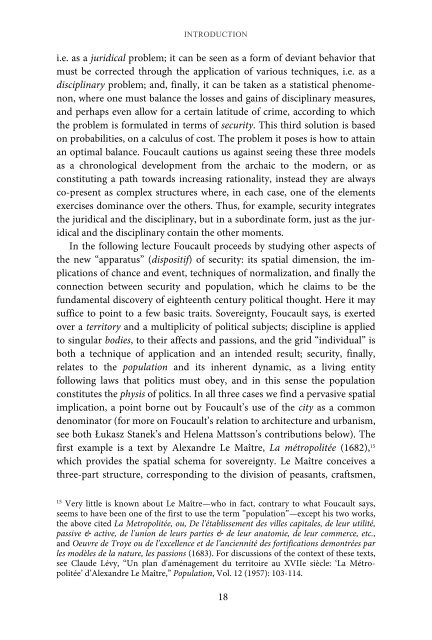Foucault, Biopolitics, and Governmentality
Foucault, Biopolitics, and Governmentality
Foucault, Biopolitics, and Governmentality
You also want an ePaper? Increase the reach of your titles
YUMPU automatically turns print PDFs into web optimized ePapers that Google loves.
INTRODUCTION<br />
i.e. as a juridical problem; it can be seen as a form of deviant behavior that<br />
must be corrected through the application of various techniques, i.e. as a<br />
disciplinary problem; <strong>and</strong>, finally, it can be taken as a statistical phenomenon,<br />
where one must balance the losses <strong>and</strong> gains of disciplinary measures,<br />
<strong>and</strong> perhaps even allow for a certain latitude of crime, according to which<br />
the problem is formulated in terms of security. This third solution is based<br />
on probabilities, on a calculus of cost. The problem it poses is how to attain<br />
an optimal balance. <strong>Foucault</strong> cautions us against seeing these three models<br />
as a chronological development from the archaic to the modern, or as<br />
constituting a path towards increasing rationality, instead they are always<br />
co-present as complex structures where, in each case, one of the elements<br />
exercises dominance over the others. Thus, for example, security integrates<br />
the juridical <strong>and</strong> the disciplinary, but in a subordinate form, just as the juridical<br />
<strong>and</strong> the disciplinary contain the other moments.<br />
In the following lecture <strong>Foucault</strong> proceeds by studying other aspects of<br />
the new “apparatus” (dispositif) of security: its spatial dimension, the implications<br />
of chance <strong>and</strong> event, techniques of normalization, <strong>and</strong> finally the<br />
connection between security <strong>and</strong> population, which he claims to be the<br />
fundamental discovery of eighteenth century political thought. Here it may<br />
suffice to point to a few basic traits. Sovereignty, <strong>Foucault</strong> says, is exerted<br />
over a territory <strong>and</strong> a multiplicity of political subjects; discipline is applied<br />
to singular bodies, to their affects <strong>and</strong> passions, <strong>and</strong> the grid “individual” is<br />
both a technique of application <strong>and</strong> an intended result; security, finally,<br />
relates to the population <strong>and</strong> its inherent dynamic, as a living entity<br />
following laws that politics must obey, <strong>and</strong> in this sense the population<br />
constitutes the physis of politics. In all three cases we find a pervasive spatial<br />
implication, a point borne out by <strong>Foucault</strong>’s use of the city as a common<br />
denominator (for more on <strong>Foucault</strong>’s relation to architecture <strong>and</strong> urbanism,<br />
see both Łukasz Stanek’s <strong>and</strong> Helena Mattsson’s contributions below). The<br />
first example is a text by Alex<strong>and</strong>re Le Maître, La métropolitée (1682), 15<br />
which provides the spatial schema for sovereignty. Le Maître conceives a<br />
three-part structure, corresponding to the division of peasants, craftsmen,<br />
15 Very little is known about Le Maître—who in fact, contrary to what <strong>Foucault</strong> says,<br />
seems to have been one of the first to use the term ”population”—except his two works,<br />
the above cited La Metropolitée, ou, De l'établissement des villes capitales, de leur utilité,<br />
passive & active, de l'union de leurs parties & de leur anatomie, de leur commerce, etc.,<br />
<strong>and</strong> Oeuvre de Troye ou de l’excellence et de l’anciennité des fortifications demontrées par<br />
les modèles de la nature, les passions (1683). For discussions of the context of these texts,<br />
see Claude Lévy, “Un plan d'aménagement du territoire au XVIIe siècle: ‘La Métropolitée’<br />
d’Alex<strong>and</strong>re Le Maître,” Population, Vol. 12 (1957): 103-114.<br />
18


